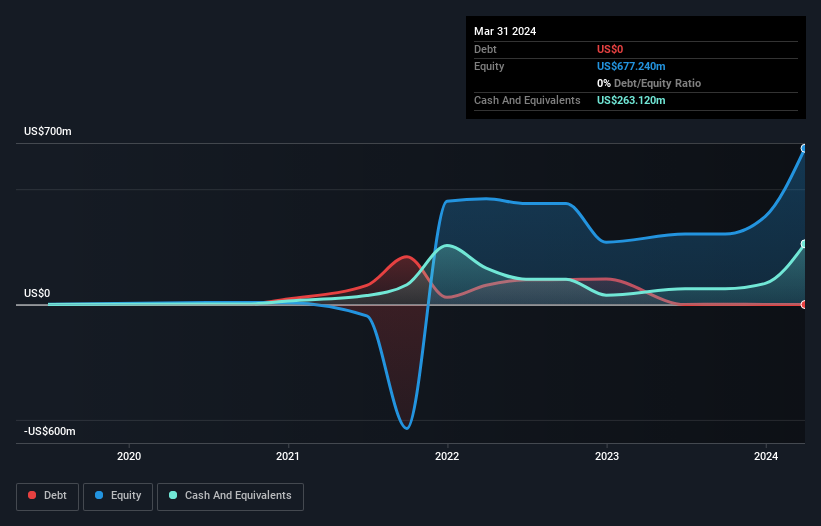- United States
- /
- Software
- /
- NasdaqGS:IREN
Here's Why We're Not At All Concerned With Iris Energy's (NASDAQ:IREN) Cash Burn Situation

We can readily understand why investors are attracted to unprofitable companies. By way of example, Iris Energy (NASDAQ:IREN) has seen its share price rise 153% over the last year, delighting many shareholders. Nonetheless, only a fool would ignore the risk that a loss making company burns through its cash too quickly.
In light of its strong share price run, we think now is a good time to investigate how risky Iris Energy's cash burn is. In this report, we will consider the company's annual negative free cash flow, henceforth referring to it as the 'cash burn'. The first step is to compare its cash burn with its cash reserves, to give us its 'cash runway'.
Check out our latest analysis for Iris Energy
When Might Iris Energy Run Out Of Money?
A cash runway is defined as the length of time it would take a company to run out of money if it kept spending at its current rate of cash burn. In March 2024, Iris Energy had US$263m in cash, and was debt-free. Looking at the last year, the company burnt through US$151m. So it had a cash runway of approximately 21 months from March 2024. Importantly, though, analysts think that Iris Energy will reach cashflow breakeven before then. In that case, it may never reach the end of its cash runway. You can see how its cash balance has changed over time in the image below.

How Well Is Iris Energy Growing?
Iris Energy reduced its cash burn by 14% during the last year, which points to some degree of discipline. But it was the operating revenue growth of 118% that really shone. It seems to be growing nicely. While the past is always worth studying, it is the future that matters most of all. For that reason, it makes a lot of sense to take a look at our analyst forecasts for the company.
How Hard Would It Be For Iris Energy To Raise More Cash For Growth?
While Iris Energy seems to be in a fairly good position, it's still worth considering how easily it could raise more cash, even just to fuel faster growth. Generally speaking, a listed business can raise new cash through issuing shares or taking on debt. Commonly, a business will sell new shares in itself to raise cash and drive growth. We can compare a company's cash burn to its market capitalisation to get a sense for how many new shares a company would have to issue to fund one year's operations.
Since it has a market capitalisation of US$1.1b, Iris Energy's US$151m in cash burn equates to about 13% of its market value. As a result, we'd venture that the company could raise more cash for growth without much trouble, albeit at the cost of some dilution.
How Risky Is Iris Energy's Cash Burn Situation?
It may already be apparent to you that we're relatively comfortable with the way Iris Energy is burning through its cash. For example, we think its revenue growth suggests that the company is on a good path. Its weak point is its cash burn reduction, but even that wasn't too bad! There's no doubt that shareholders can take a lot of heart from the fact that analysts are forecasting it will reach breakeven before too long. After considering a range of factors in this article, we're pretty relaxed about its cash burn, since the company seems to be in a good position to continue to fund its growth. Taking an in-depth view of risks, we've identified 3 warning signs for Iris Energy that you should be aware of before investing.
Of course, you might find a fantastic investment by looking elsewhere. So take a peek at this free list of interesting companies, and this list of stocks growth stocks (according to analyst forecasts)
New: AI Stock Screener & Alerts
Our new AI Stock Screener scans the market every day to uncover opportunities.
• Dividend Powerhouses (3%+ Yield)
• Undervalued Small Caps with Insider Buying
• High growth Tech and AI Companies
Or build your own from over 50 metrics.
Have feedback on this article? Concerned about the content? Get in touch with us directly. Alternatively, email editorial-team (at) simplywallst.com.
This article by Simply Wall St is general in nature. We provide commentary based on historical data and analyst forecasts only using an unbiased methodology and our articles are not intended to be financial advice. It does not constitute a recommendation to buy or sell any stock, and does not take account of your objectives, or your financial situation. We aim to bring you long-term focused analysis driven by fundamental data. Note that our analysis may not factor in the latest price-sensitive company announcements or qualitative material. Simply Wall St has no position in any stocks mentioned.
About NasdaqGS:IREN
Undervalued with high growth potential.
Similar Companies
Market Insights
Community Narratives




